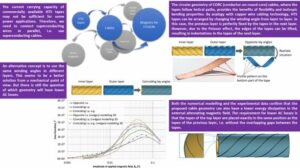Superconducting tapes are attractive for use in magnets because they combine several favorable properties: a high upper critical field, good mechanical strength and a high critical current density of the ReBCO layer.
The increase in current carrying capacity could be achieved by assembling many coated conductor (CC) tapes in parallel paths in a superconducting cable. Several cabling concepts have been developed for the cabling of CC tapes: Roebel cable, twisted stack, Rutherford cable and the CORC®/CORT arrangement, realized as conductor on round core and conductor on round tube respectively. The circular geometry of CORC, where the tapes follow helical paths, offers the advantages of flexibility and isotropic bending properties. By analogy with copper wire cabling technology, CC tapes can be arranged by changing the lay angle from layer to layer. The previous layer is then perfectly fixed by the tapes in the next layer. However, the edges of the tapes can be raised due to the Poisson effect, and if the direction of helicity is different, this will result in indentations in the tapes in the next layer. It is therefore useful to investigate the case where the tapes in all layers follow the same helicity. The lower mechanical pressure due to the larger contact area and the longitudinal orientation of the edges makes this geometry more preferable.
Our colleauges from department of superconductors recently published a study comparing AC losses in three cases of mutual tape arrangement in a round cable. The prediction of AC losses in CORC cables requires 3D numerical models. The lower AC losses, also confirmed by experiments, were found in the case of a cable geometry defined as a helically wound stack of tapes on the round core. The disadvantages are a poorer current distribution between the tapes and an additional inductance introduced by the coincident geometry. The reduction in AC loss of such a cable is observed in the mid-field range and could be exploited in some cases, such as power cables and cables exposed to not very high external MFs.
Source: Magnetization AC losses in multilayer superconducting round cables with coinciding and opposite lay angles, DOI: 10.1088/1361-6668/acb08e
 Prepared by: M. Soloviov
Prepared by: M. Soloviov
 Prepared by: M. Soloviov
Prepared by: M. Soloviov 




